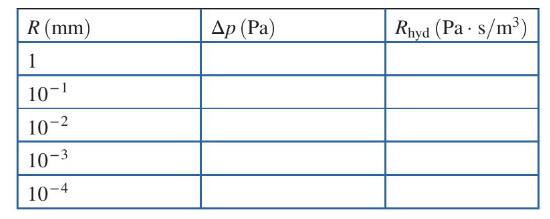Consider fully developed pressure-driven flow in a cylindrical tube of radius, (R), and length, (L=10 mathrm{~mm}), with
Question:
Consider fully developed pressure-driven flow in a cylindrical tube of radius, \(R\), and length, \(L=10 \mathrm{~mm}\), with flow generated by an applied pressure gradient, \(\Delta p\). Tests are performed with room temperature water for various values of \(R\), with a fixed flow rate of \(Q=10 \mu \mathrm{L} / \mathrm{min}\). The hydraulic resistance is defined as \(R_{\text {hyd }}=\) \(\Delta p / Q\) (by analogy with the electrical resistance \(R_{\text {elec }}=\Delta V / I\), where \(\Delta V\) is the electrical potential drop and \(I\) is the electric current). Calculate the required pressure gradient and hydraulic resistance for the range of tube radii listed in the table. Based on the results, is it appropriate to use a pressure gradient to pump fluids in microchannels, or should some other driving mechanism be used?

Step by Step Answer:

Fox And McDonald's Introduction To Fluid Mechanics
ISBN: 9781118912652
9th Edition
Authors: Philip J. Pritchard, John W. Mitchell





